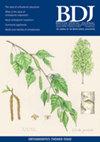非手术根管治疗:根管系统的现代生物力学准备
IF 2
4区 医学
Q2 DENTISTRY, ORAL SURGERY & MEDICINE
引用次数: 0
摘要
本文章由计算机程序翻译,如有差异,请以英文原文为准。

Non-surgical endodontics: contemporary biomechanical preparation of the root canal system
Treatment of apical periodontitis requires disinfection of the root canal system through means of biomechanical preparation. This is achieved by a process of shaping the root canal space while simultaneously using antibacterial agents to reduce microbiological load in the root canal system in order for inflammation of the periradicular tissues to resolve and the body to heal itself. The fundamental principles underlying this process have not changed in decades; however, in contrast, the armamentarium available to the clinician continues to evolve rapidly. Nickel-titanium file design has made a significant step forward in the last ten years. Areas of development have focused on the metallurgic properties, motion of the instrument and cross-sectional design. The resulting contemporary designs have allowed the clinician to manage more complex root canal systems more predictably in situations which would otherwise have proved difficult using conventional techniques; effectively, it has made it easier to prepare a root canal. These newer systems also require fewer instruments to prepare a canal and some, which have adopted a reciprocating (rotational) motion, may only require one engine-driven file. Significant energy has been devoted to attempting to enhance efficacy of irrigant activity using different techniques. Although this has shown promise in in vitro studies, this has yet to be shown to translate to an improved clinical success rate based on comparative clinical studies performed. Contemporary biomechanical techniques used to clean and shape the root canal system should result in improved confidence and predictability when managing endodontic disease.
求助全文
通过发布文献求助,成功后即可免费获取论文全文。
去求助
来源期刊

British Dental Journal
医学-牙科与口腔外科
CiteScore
3.10
自引率
15.40%
发文量
1096
审稿时长
4-8 weeks
期刊介绍:
The role of the BDJ is to inform its readers of ideas, opinions, developments and key issues in dentistry - clinical, practical and scientific - stimulating interest, debate and discussion amongst dentists of all disciplines. All papers published in the BDJ are subject to rigorous peer review.
 求助内容:
求助内容: 应助结果提醒方式:
应助结果提醒方式:


